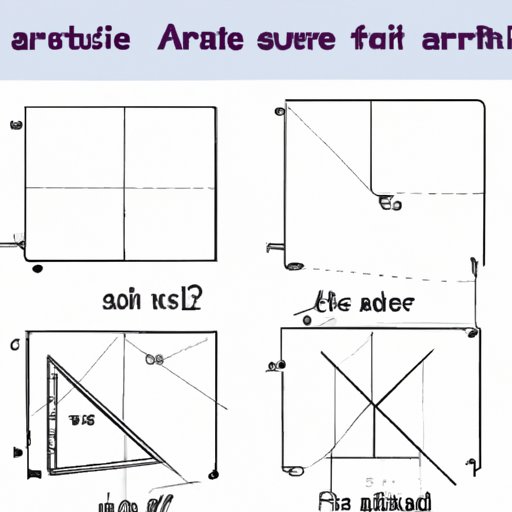Introduction
Area is a fundamental concept in math and geometry. It refers to the amount of space inside a two-dimensional figure, such as a square, circle, or triangle. The ability to find area accurately is essential in various fields such as carpentry, construction, architecture, engineering, and many more. In this article, we will walk you through step-by-step on how to find area, give practical examples, cover common formulas, and clarify common misconceptions.
Step-by-Step Guide with Visuals
The process of finding the area of any two-dimensional figure involves using a specific formula or method. The formulas vary based on the shape of the figure. Here are a few general steps to follow when finding the area of any shape:
1. Identify the shape and size of the figure
2. Identify the necessary measurements needed to calculate area such as length, width, radius, and height (for 3D shapes)
3. Choose the appropriate formula for the figure you want to solve.
4. Plug the measurements into the formula and solve.
It is crucial to pay attention to precision, especially when measuring. A slight mistake could lead to a significant difference in the final result.
Examples and Practice Problems
Let’s practice finding areas of different shapes using formulas.
Example 1: Find the area of a rectangle with a length of 4 cm and a width of 6 cm.
Solution: Area = Length x Width
Area = 4 cm x 6 cm = 24 cm2
Example 2: Find the area of a circle with a radius of 3 m.
Solution: Area = π x radius2
Area = π x (3m)2 = 28.27m2
Now let us practice some problems together.
Practice problem 1: Find the area of a triangle with base 5 m and height 2 m.
Practice problem 2: Find the area of a parallelogram with base 20 cm and height 8 cm.
Practice problem 3: Find the area of a trapezium with base 5 cm, top length 4 cm, and height 3 cm.
Common Formulas
Knowing a few formulas is essential when finding areas. Below we have listed a few of the most commonly used formulas.
Rectangle: Area = Length x Width
Square: Area = Length x Length
Triangle: Area = (1/2) x Base x Height
Trapezium: Area = (1/2) x (Base1 + Base2) x Height
Circle: Area = π x radius2
While these formulas are easy to remember, it is important to note that some shapes might require a different formula or combination of formulas.
Real-life Application
Finding area is used in everyday life, particularly in construction, carpentry, landscaping, and many other fields. For instance, when measuring a room to replace carpeting or tiling, finding the area is essential to determine how much material is needed. Similarly, when painting a room, finding the area of the wall is vital in calculating how much paint is required.
In the construction and engineering fields, finding area is critical in determining the required amount of material for construction, including concrete, asphalt, or steel, among others. Finding the area also plays a vital role in determining the capacity and target areas for storage facilities such as barns, warehouses, and factories.
Compare and Contrast
Finding the area of different shapes demands varied formulas and processes. For example, finding the area of a rectangle involves multiplying the length and the width of the rectangle. Finding the circumference of a circle involves using pi and the radius squared. Similarly, finding the area of a parallelogram involves multiplying the base and height of the figure. Some shapes such as irregular polygons might require dividing the shape into different sections to calculate the individual shapes’ areas.
History of Area Measurement
The history of area measurement dates back to ancient Egyptians and Greeks who applied distinctive methods to measure land areas. Over time, different countries and civilizations have developed their measuring systems. The metric system, which is the standard measuring system today, was enacted by the United States in the 19th century. Currently, other measurement standards, such as international feet, yards, and acres, work in different countries worldwide.
Common Misconceptions
One of the most common misconceptions in finding area is confusing it with perimeter. Perimeter is the distance around the outside of a two-dimensional figure. On the other hand, area refers to the space inside the figure.
Conclusion
Finding the area is a crucial concept in math and geometry, with numerous real-life applications in various fields. By following our step-by-step guide with visuals, learning different formulas, and applying to practice problems, you will find it easier to determine the area of your preferred figure. Keep in mind the importance of accuracy when measuring, as well as clarifying misconceptions that might hinder proper understanding. With these tools in hand, mastering how to calculate area will soon be a breeze.
